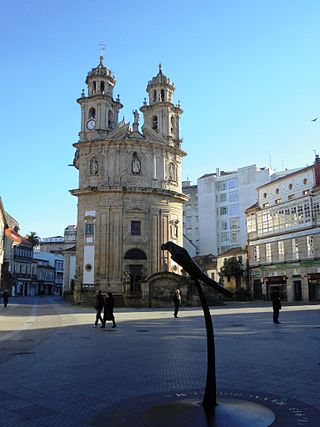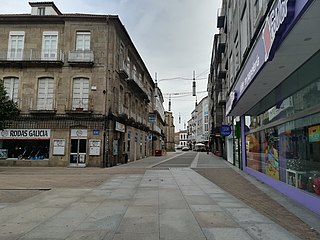
Pontevedra is a city in the autonomous community of Galicia, in northwestern Spain. It is the capital of both the Comarca and Province of Pontevedra, and the capital of the Rías Baixas. It is also the capital of its own municipality which is often considered an extension of the actual city.

The Convent of St. Clare is a former cloistered convent of the Order of Poor Clares, located in the city centre of Pontevedra, Spain, precisely in Santa Clara Street, near the disappeared St. Clare Gate of the medieval city walls. Founded in 1271, the convent closed in 2017. In 2021 the City Council bought the building from the Order, and in 2023 it transferred it to the Provincial Deputation to become part of the Pontevedra Museum.

The Praza da Ferrería is a large square located on the edge of the old town of Pontevedra (Spain), inside the old city walls. It is the main square of the old town and has an area of about 2,000 m2. It includes the small squares of the Estrella on the north side, the Orense square on the south side and the Casto Sampedro square on the east side, making a total of almost 5,000 m2.

The Mendoza mansion is a building located between Santa María Avenue and Arzobispo Malvar Street, at the western end of the old town of Pontevedra. It is currently the headquarters of the Rias Bajas Tourist Office.

The Plaza de Teucro is a square of medieval origin located in the heart of the old town of Pontevedra (Spain). It is the most harmoniously proportioned medieval square in the city.

The Plaza de la Verdura is a square of medieval origin located in the heart of the historic centre of Pontevedra (Spain). It is one of the liveliest medieval squares in the city.

Méndez Núñez Square is a square of medieval origin located in the heart of the historic centre of Pontevedra (Spain).

O Burgo is a neighbourhood in the city of Pontevedra (Spain). It is one of the oldest neighbourhoods in the city and is crossed by the Portuguese Way. On its right-hand side is the A Xunqueira area with important educational and cultural facilities.

The Plaza de la Peregrina is an 18th-century square located in the city centre of Pontevedra (Spain), on the edge of the historic centre.

The Plaza de España is a 19th century pedestrian square located in the city centre of Pontevedra (Spain), on the edge of the old town and the Alameda de Pontevedra.

The Plaza de Galicia is a 20th century square located in the city centre of Pontevedra (Spain), on the edge of the Campolongo neighbourhood.

Curros Enríquez Square is a square of medieval origin located in the heart of the historic centre of Pontevedra (Spain), on the Portuguese pilgrimage way.

St. Joseph's Square is a 19th century square located in the centre of the city of Pontevedra (Spain), in the first urban expansion area, near the Campolongo neighbourhood.

The calle Benito Corbal is a street in Pontevedra (Spain) located in the first urban expansion area of the city. It is one of the main streets of Pontevedra, known as the "Golden Mile".

The Calle García Camba is a street in Pontevedra (Spain) located in the city centre, in the first urban expansion area. It is one of the main streets of Pontevedra.

Calle Real is a street in the Spanish city of Pontevedra, located in the city's historic centre.

The Calle Daniel de la Sota is a central street in the Spanish city of Pontevedra, located in the city's first expansion area. It is one of the best-known streets in Pontevedra.

The Marquis of Riestra street is a central street in the Spanish city of Pontevedra, in the first expansion zone of the city in the 19th century, running longitudinally parallel to the Palm Trees Park on its eastern side. It is one of the main streets in Pontevedra city centre.

The Ensanche of Pontevedra is the neighbourhood that forms the centre of the Spanish city of Pontevedra, made up of several successive extensions to the city outside the old town. The term Ensanche means " widening " in Spanish and refers to the expanding areas of Spanish cities towards the end of the 19th century, when the demographic explosion and the industrial revolution led to the demolition of the old city walls and the construction of new areas outside the old fortified walls.

The Fountain of A Ferrería is a fountain located in the gardens of Casto Sampedro next to the Ferrería square in the Spanish city of Pontevedra. It is a Renaissance-style granite fountain.

























